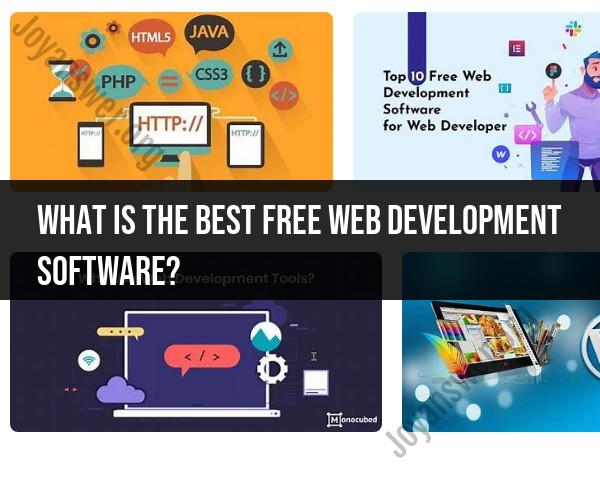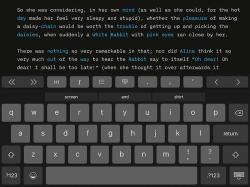What is the best free web development software?
The best free web development software can depend on various factors, including the specific needs of the developer, the type of projects they are working on, and their personal preferences. Here is an overview of some widely used and highly regarded free web development tools:
Visual Studio Code:
- Description: Visual Studio Code, developed by Microsoft, is a popular source-code editor known for its speed, versatility, and extensive extensions. It supports a wide range of programming languages and offers features like IntelliSense, Git integration, and a powerful debugging interface.
- Key Features: Lightweight, powerful code editing, extension support.
Atom:
- Description: Atom is an open-source text editor developed by GitHub. It's customizable, user-friendly, and has a vibrant community. Atom supports various packages and themes, making it adaptable to different programming environments.
- Key Features: Highly customizable, built-in package manager.
Sublime Text:
- Description: Sublime Text is a sophisticated text editor with a minimalist design. It is known for its speed, responsiveness, and a wide range of keyboard shortcuts. While it's not open source, it offers an unlimited free trial.
- Key Features: Speed, multi-caret editing, extensive plugin ecosystem.
Brackets:
- Description: Brackets is an open-source text editor developed by Adobe. It's designed specifically for web development, with features like live preview, preprocessor support, and visual tools for designing in the browser.
- Key Features: Live preview, preprocessor support, inline editing.
Eclipse IDE:
- Description: Eclipse is a versatile integrated development environment (IDE) that supports multiple languages, including Java, C++, and PHP. It provides a range of plugins and features for web development projects.
- Key Features: Extensible, rich plugin ecosystem.
NetBeans:
- Description: NetBeans is an open-source IDE that supports Java, JavaScript, HTML, and other languages. It offers features like code debugging, profiling, and a user-friendly interface.
- Key Features: Smart coding assistance, modular architecture.
GitHub Desktop:
- Description: GitHub Desktop is a desktop application that simplifies version control and collaboration using Git. It provides an easy-to-use interface for managing repositories, branches, and commits.
- Key Features: User-friendly Git interface, branch management.
Notepad++:
- Description: Notepad++ is a lightweight text editor with support for multiple languages. While it may not be a full-fledged IDE, it is fast, customizable, and suitable for quick edits and scripting.
- Key Features: Speed, extensibility, syntax highlighting.
GIMP (GNU Image Manipulation Program):
- Description: While not specifically for coding, GIMP is a powerful, open-source image editor. It's useful for creating and editing web graphics and design elements.
- Key Features: Advanced image editing capabilities, extensible through plugins.
FileZilla:
- Description: FileZilla is an open-source FTP client that simplifies file transfer between a local machine and a web server. It supports FTP, FTPS, and SFTP protocols.
- Key Features: Easy file transfer, cross-platform support.
These tools cater to different aspects of web development, from code editing to version control and graphic design. The best choice depends on the developer's preferences, the type of projects they are working on, and the languages they are using. Many developers also use a combination of these tools based on their specific needs.
Demystifying Free Web Development Software: Features, Choices, and Limitations
Building stunning websites doesn't always require breaking the bank. Several excellent free web development tools out there can help you bring your vision to life.
1. Key Features of Top Free Web Development Software:
- Visual Editing: Drag-and-drop interfaces enable building layouts and inserting elements without coding.
- Pre-built templates and themes: Jumpstart your design with ready-made options.
- Mobile-responsiveness: Design websites that adapt to different screen sizes.
- Basic content management: Add and edit text, images, and multimedia content.
- Collaboration features: Share projects and work with others in real-time.
- Integrations: Connect with third-party services and plugins for added functionality.
2. Comparison to Paid Options:
- Functionality: Free tools may lack advanced features like custom code editing, e-commerce capabilities, or comprehensive analytics.
- Control and customization: Paid options offer greater flexibility and control over website design and functionality.
- Support and resources: Free tools may have limited customer support and learning resources compared to paid subscriptions.
- Scalability: As your project grows, you might outgrow the capabilities of free software and require paid upgrades.
3. Recommended Free Tools for Beginners:
- WordPress: Widely used CMS platform with user-friendly interface and vast learning resources.
- Bootstrap: CSS framework for responsive website building with pre-styled components.
- Visual Studio Code: Popular open-source code editor with extensions for various languages and frameworks.
- Canva: Design tool for creating graphics, logos, and mockups to visualize your website.
- Unsplash and Pexels: Free access to high-quality images for your website.
4. Choosing the Best Free Tool:
- Project requirements: Identify the features and functionalities you need for your website.
- Skill level: Choose a tool that matches your coding experience and comfort level.
- Learning resources: Consider available tutorials, documentation, and community support.
- Future growth: Ensure the tool can scale with your project's complexity.
5. Limitations of Free Tools:
- Limited features: Might lack specific functionalities you need for complex projects.
- Branding restrictions: Some free tools might display their branding on your website.
- Support limitations: Access to customer support might be limited or non-existent.
- Security concerns: Some free tools might have lower security standards.
Remember, free web development software can be a fantastic starting point for learning and building basic websites. However, as your project's complexity and needs grow, consider transitioning to paid options for greater control, scalability, and advanced features.
With dedicated effort and the right tools, you can turn your web development dreams into reality, even without a hefty budget. Good luck!




